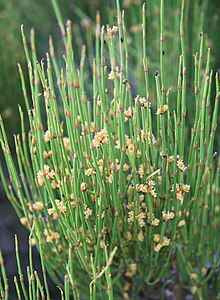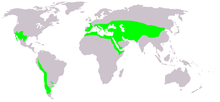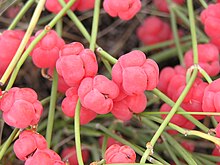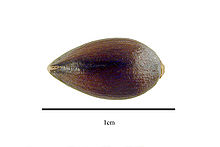Ephedra (plant)
| Ephedra Temporal range:
| |
|---|---|

| |
| Ephedra viridis | |
| Scientific classification | |
| Kingdom: | Plantae |
| Clade: | Tracheophytes |
| Clade: | Gymnospermae |
| Division: | Gnetophyta |
| Class: | Gnetopsida |
| Order: | Ephedrales |
| Family: | Ephedraceae |
| Genus: | Ephedra L.[1] |
| Type species | |
| Ephedra distachya | |

| |
| Global range of Ephedra | |
| Synonyms[2] | |
| |
Ephedra is a genus of gymnosperm shrubs. The various species of Ephedra are widespread in many arid regions of the world, ranging across southwestern North America, southern Europe, northern Africa, southwest and central Asia, northern China and western South America.[2] It is the only extant genus in its family, Ephedraceae, and order, Ephedrales, and one of the three living members of the division Gnetophyta alongside Gnetum and Welwitschia.
In



Description
The family
The stems are green and photosynthetic.[4] The leaves are opposite or whorled. The scalelike leaves fuse into a sheath at the base and this often sheds soon after development. There are no resin canals.[3]
The plants are mostly dioecious, with the pollen strobili in whorls of 1–10, each consisting of a series of decussate[5] bracts. The pollen is furrowed. The female strobili also occur in whorls, with bracts which fuse around a single ovule. Fleshy bracts are white (such as in Ephedra frustillata) or red. There are generally 1–2 yellow to dark brown seeds per strobilus.[3]
Taxonomy
The genus Ephedra was first described in 1753 by
Evolutionary history
The oldest known members of the genus are from the Early Cretaceous around 125 million years ago, with records being known from the Aptian-Albian of Argentina,[10] China,[11] Portugal and the United States.[12] The fossil record of Ephedra outside of pollen disappears after the Early Cretaceous.[13] Molecular clock estimates have suggested that last common ancestor of living Ephedra species lived much more recently, during the Early Oligocene around 30 million years ago.[14] However, pollen modified from the ancestral condition of the genus with branched pseudosulci (grooves), which evolved in parallel in the living North American and Asian lineages is known from the Late Cretaceous, suggesting that the last common ancestor is at least this old.[13]
Species
| Phylogeny of Ephedra[15][16] | ||||||||||||||||||||||||||||||||||||||||||||||||||||||||||||||||||||||||||||||||||||||||||||||||||||||||||||
|
As of June 2021[update], Plants of the World Online accepted the following species:[17]
- Ephedra alata Decne. – North Africa, Arabian Peninsula
- Ephedra altissima Desf. non-Bové (1834), non-Delile (1813), non-Buch (1828) (High-climbing jointfir) – North Africa, Canary Islands
- Ephedra antisyphilitica Berland ex C.A.Mey. – Clapweed, Erect Ephedra – Texas, Oklahoma, New Mexico, Nuevo León, Coahuila, Chihuahua
- Ephedra aphylla Forssk. – eastern Mediterranean from Libya and Cyprus to the Persian Gulf
- Ephedra × arenicola H.C.Cutler – Arizona, Utah (hybrid, E. cutleri × E. torreyana)
- Ephedra aspera Engelm. ex S.Watson – Boundary Ephedra, Pitamoreal – Texas, New Mexico, Arizona, Utah, Nevada, California, Chihuahua, Durango, Zacatecas, Sinaloa, Sonora, Baja California
- Ephedra aurantiaca Takht. & Pachom. – Caucasus, Kazakhstan, Turkmenistan
- Ephedra aurea Brullo et al.
- Ephedra boelckei F.A.Roig – Argentina
- Ephedra botschantzevii Pachom. – Kazakhstan, Tuva region of Siberia
- Ephedra breana Phil. (frutilla de campo) – Peru, Bolivia, Chile, Argentina
- Ephedra brevifoliata Ghahr. – Iran
- Ephedra californica S.Watson – California Ephedra, California Jointfir – California, western Arizona, Baja California
- Ephedra chengiae Yang & Ferguson
- Ephedra chilensis C.Presl – Pingo-pingo - Chile, Argentina
- Ephedra compacta Rose – widespread in much of Mexico
- Ephedra coryi E.L.Reed (Cory's Ephedra) – Texas, New Mexico
- Ephedra cutleri Peebles – Navajo Ephedra, Cutler's Ephedra, Cutler Mormon-tea, Cutler's Jointfir – Colorado, Utah, Arizona, New Mexico, Wyoming
- Ephedra dawuensis Y.Yang – Sichuan
- Ephedra distachya L. – Joint-pine, Jointfir – southern Europe and central Asia from Portugal to Kazakhstan
- Ephedra × eleutherolepis V.A.Nikitin – Tajikistan (hybrid E. intermedia × E. strobilacea)
- Ephedra fasciculata A.Nelson – Arizona Ephedra, Arizona Jointfir, Desert Mormon-tea – Arizona, California, Nevada, Utah
- Ephedra fedtschenkoae Paulsen – Central Asia, Siberia, Mongolia, Xinjiang
- Santa Barbara Countyof California
- Ephedra foliata Boiss. ex C.A.Mey. (Shrubby horsetail) – North Africa, Somalia, Middle East, India
- Ephedra fragilis Desf. (joint pine) – Mediterranean, Canary Islands, Madeira
- Ephedra frustillata Miers – Patagonian Ephedra – Chile, Argentina
- C.V.Morton– Death Valley Ephedra, Death Valley Jointfir – California, Arizona, Nevada
- Ephedra gerardiana Wall. ex Klotzsch & Garcke – Gerard's Jointfir, Shan Ling Ma Huang – Himalayas, Tibet, Yunnan, Siberia, Central Asia
- Ephedra gracilis Phil. ex Stapf
- Ephedra holoptera Riedl – Iran
- Schrenk & C.A.Mey.(Zhong Ma Huang) – China, Siberia, Central Asia, Himalayas, Iran, Pakistan
- Ephedra kardangensis P.Sharma & P.L.Uniyal – western Himalayas
- Ephedra khurikensis P.Sharma & P.L.Uniyal – western Himalayas
- Ephedra laristanica Assadi – Iran
- Ephedra likiangensis Florin – Guizhou, Sichuan, Tibet, Yunnan
- Schrenk– Kazakhstan, Tuva region of Siberia
- Ephedra major Host – Mediterranean, Middle East, Central Asia; from Canary Islands to Kashmir
- Ephedra milleri Freitag & Maier-St. – Oman, Yemen
- Ephedra minuta Florin – Qinghai, Sichuan
- Ephedra monosperma J.G.Gmel. ex C.A.Mey. (dan zi ma huang) – Siberia, Mongolia, much of China including Tibet and Xinjiang
- Ephedra multiflora Phil. ex Stapf – Chile, Argentina
- Ephedra nevadensis S.Watson – Nevada Ephedra, Nevada Jointfir, Nevada Mormon-tea – Baja California, California, Arizona, Nevada, Utah, Oregon
- Ephedra ochreata Miers – Argentina
- Ephedra oxyphylla Riedl – Afghanistan
- Ephedra pachyclada Boiss. – Middle East from Sinai and Yemen to Pakistan
- Ephedra pangiensis Rita Singh & P.Sharma
- Ephedra pedunculata Engelm. ex S.Watson – Vine Ephedra, Vine Jointfir – Texas, Chihuahua, Coahuila, Durango, San Luis Potosí, Nuevo León, Zacatecas
- Ephedra pentandra Pachom. – Iran
- Ephedra procera Fisch. & C.A.Mey. − Iran, Caucasus
- Ephedra przewalskii Stapf – Central Asia, Mongolia, Pakistan, Gansu, Inner Mongolia, Ningxia, Qinghai, Tibet
- Ephedra pseudodistachya Pachom. – Siberia, Mongolia
- Ephedra regeliana Florin – Xi Zi Ma Huang – Central Asia, Siberia, Pakistan, Xinjiang
- Ephedra rhytidosperma Pachom., syn. E. lepidosperma C.Y.Cheng – Gansu, Inner Mongolia, Ningxia, Mongolia
- Ephedra rituensis Y.Yang, D.Z.Fu & G.H.Zhu – Qinghai, Xinjiang, Tibet
- Ephedra rupestris Benth. – Ecuador, Peru, Bolivia, Argentina
- Hemsl.– Pakistan, Afghanistan
- Ephedra saxatilis (Stapf) Royle ex Florin
- Ephedra sinica Stapf – Cao Ma Huang, Chinese ephedra – Mongolia, Siberia, Primorye, Manchuria
- Ephedra somalensis Freitag & Maier-St. – Somalia, Eritrea
- Ephedra stipitata Biswas & Rita Singh
- Bunge– Iran, Central Asia
- Ephedra strongylensis Brullo et al.
- Ephedra sumlingensis P.Sharma & P.L.Uniyal – western Himalayas
- Ephedra tilhoana Maire – Chad
- Ephedra torreyana S.Watson – Torrey's Ephedra, Torrey's Jointfir, Torrey's Mormon-tea, Cañutillo – Nevada, Utah, Colorado, Arizona, New Mexico, Texas, Chihuahua
- Ephedra transitoria Riedl – Iraq, Syria, Palestine, Saudi Arabia
- Tul.− Bolivia, Argentina
- Ephedra trifurca Torrey ex S.Watson – Longleaf Ephedra, Longleaf Jointfir, Longleaf Mormon-tea, Popotilla, Teposote – California, Arizona, New Mexico, Texas, Chihuahua, Sonora, Baja California
- Ephedra trifurcata Zöllner
- Ephedra tweedieana C.A.Mey. – Brazil, Argentina, Uruguay
- Ephedra viridis Coville – Green Ephedra, Green Mormon-tea – California, Nevada, Utah, Arizona, New Mexico, Colorado, Wyoming, South Dakota, Oregon
- Ephedra vvedenskyi Pachom. – Iran, Caucasus, Turkmenistan
- Ephedra yangthangensis Prabha Sharma & Rita Singh – Yangthang to Ka, Leo, Nako, Chango, Chulling, Sumdo, Hoorling and Lira of Kinnaur district of Himachal Pradesh[18]
Distribution
The genus is found worldwide, in desert regions, but not in Australia.[3]
Ecology
Ephedraceae are adapted to extremely arid regions, growing often in high sunny habitats, and occur as high as 4000 m above sea level in both the Andes and the Himalayas.[3] They make up a significant part of the North American Great Basin sage brush ecosystem.
Drug and supplement uses
The Ephedra
In the United States, ephedra supplements were banned from the market in the early 21st century due to serious safety risks.
Ephedra has also had a role as a precursor in the clandestine manufacture of methamphetamine.[21]
Adverse effects
Alkaloids obtained from the species of Ephedra used in herbal medicines, which are used to synthetically prepare pseudoephedrine and ephedrine, can cause cardiovascular events.[19] These events have been associated with arrhythmias, palpitations, tachycardia and myocardial infarction.[19] Caffeine consumption in combination with ephedrine has been reported to increase the risk of these cardiovascular events.[19][20]
Economic botany and alkaloid content
The earliest uses of Ephedra species (mahuang) for specific illnesses date back to 5000 BC.
For a review of the alkaloid distribution in different species of the genus Ephedra see Jian-fang Cui (1991).[23] Other American and European species of Ephedra, e.g. Ephedra nevadensis (Nevada Mormon tea) have not been systematically assayed; based on unpublished field investigations, they contain very low levels (less than 0.1%) or none at all.[24]
See also
References
- ISBN 3540517944.
- ^ a b Kew World Checklist of Selected Plant Families
- ^ a b c d e Judd WS, Campbell CS, Kellog EA, Stevens PF, Donoghue MJ (2007). Plant Systematics, a phylogenetic approach (3rd. ed.). Sinauer associates, Inc.
- ^ "Family "Ephedraceae"". Angiosperm Phylogeny Website. Retrieved 5 July 2019.
- ^ Messina A (2014). "VicFlora: Ephedraceae". Victoria, Australia: Royal Botanic Gardens Foundation. Retrieved 5 July 2019.
- ^ a b The Gymnosperm database: Ephedra. Retrieved 5 July 2019.
- ^ a b Linnaeus C (1753). Species Plantarum. Vol. 2. p. 1040.
- ^ Linnaeus C (1754). Genera plantarum. Vol. 5. p. 462.
- ^ Dumortier BC (1829). Analyse des familles des plantes, avec l'indication des principaux genres qui s'y rattachent. Tournay: J. Casterman aîné. p. 11.
- S2CID 23766815.
- PMID 23341964.
- PMID 16675607.
- ^ S2CID 83696018.
- ISSN 1759-6831.
- S2CID 232282918.
- )
- ^ "Ephedra Tourn. ex L." Plants of the World Online. Royal Botanic Gardens, Kew. Retrieved 23 June 2021.
- .
- ^ a b c d e "Ephedrine". Drugs.com. 9 January 2021. Retrieved 23 June 2021.
- ^ a b c d "Ephedra". National Center for Complementary and Integrative Health, US National Institutes of Health. 1 July 2020. Retrieved 23 June 2021.
- ^ "Ephedra's Role As a Precursor in the Clandestine Manufacture of Methamphetamine". Journal of Forensic Sciences 40(4), 551-560 (1995). Retrieved 30 December 2021.
- ISBN 0-12-469535-3.
- PMID 15635242.
- PMID 15084081.
External links
- Ephedra viridis (Plants for a Future Database)
- Usage in Chinese Medicine
- Ephedra fact sheet, NIHNational Center for Complementary and Integrative Health
- Ephedrea (Evidence and dosing) Archived 22 September 2017 at the Wayback Machine, Mayo Clinic
- Ephedra – Clinical summary and mechanism of action, MSKCCMemorial Sloan Kettering Cancer Center
- Ephedraceae of Mongolia in FloraGREIF Archived 4 April 2016 at the Wayback Machine
